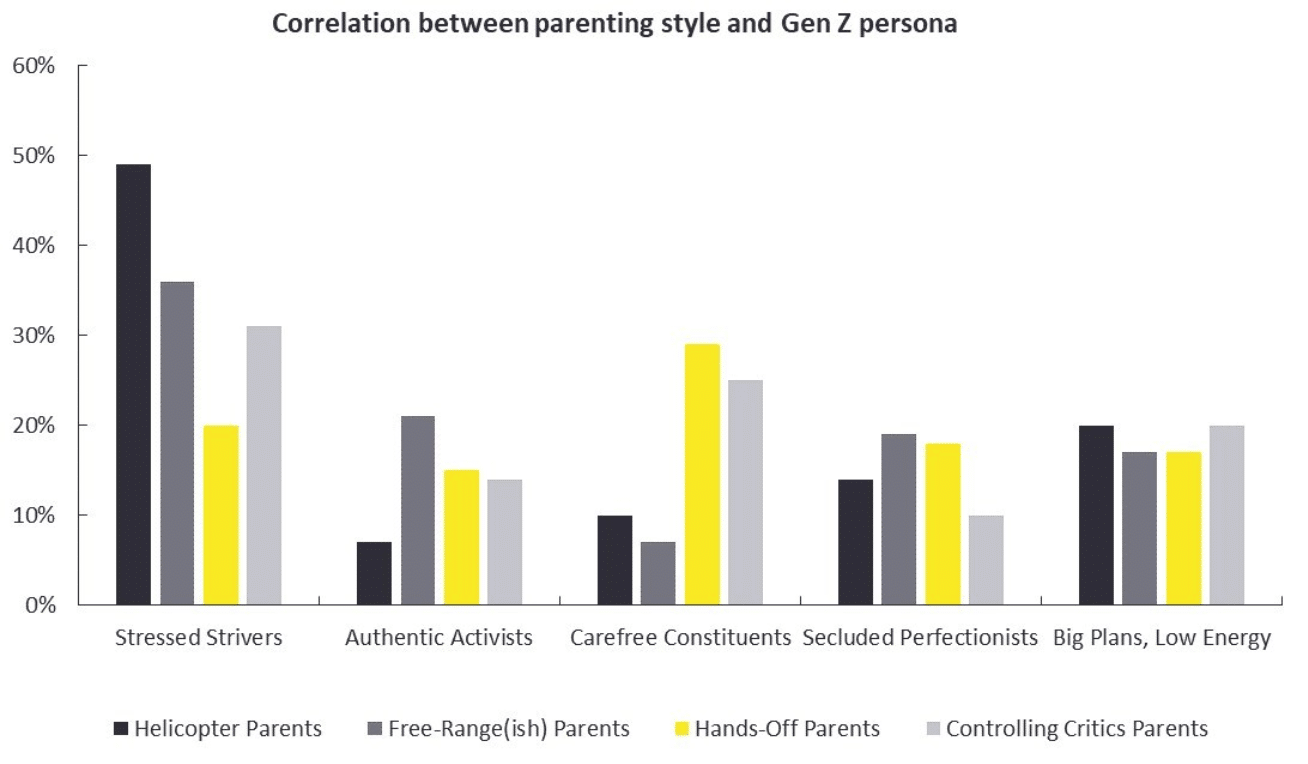As Gen Z begins to enter the workforce and flex its newfound spending power, connecting with them is critical for brand communicators. But employers and business leaders take note: a one-size-fits-all approach to defining a generation will cost talent and customers. It’s important to identify and acknowledge the differences within the generation—something many employers and business leaders failed to do with millennials, to their own detriment.
Tax, transaction and advisory firm Ernst & Young recently released its Gen Z Segmentation Study, which confirms bucketing the most diverse generation to date into one simple type—despite their individual characteristics, goals and values—will be a costly mistake.
Don’t assume anything—Gen Z contradicts many expectations
Gen Z is a walking contradiction to society and past youth when it comes to social media usage, core values and politics. Employers and business leaders should get to know the generation before basing plans on stereotypes.
- Social media: Today’s youth are perceived to be obsessed with their social media activities, and while 84 percent of Gen Z say they have a social media account, they use it more for communication than for public sharing like past generations. When asked to choose their top reasons for using social media, EY research found:
- 80 percent of Gen Z use social media to connect with family and friends
- 72 percent use it to satisfy boredom
- 41 percent use it to stay up to date on news
- 22 percent share opinions through social sites
- Values: Today’s youth are driven and future-thinking, with 79 percent saying doing well in school is very or extremely important and 72 percent spending time on activities that will help them in the future.
- Politics: The assumption is that Gen Z is liberal, but the research shows that these young people represent the diversity of the political spectrum. The majority view themselves as moderate (39 percent), with an almost-even split between liberal (28 percent) and conservative (25 percent), and the smallest percentage falling into the “other” column (8 percent).
These identities provide the foundation for the five key Gen Z segments.
The power of five
The study identifies the five segments of the Gen Z population and shows how much of the population each segment represents:
- Stressed Strivers (35 percent)
These high achievers are driven by a fear of not being good enough. Stressed Strivers care less about wanting to enjoy their work and more about achieving success and feeling respected. They place importance on spending time on things that will help them in the future, believe in being independent and figuring things out on their own and favor earning what they get rather than having it handed to them. They are also keenly interested in environmental issues.
- Big Plans, Low Energy (18 percent)
They expect to do well and make money, but aren’t necessarily willing to put in the effort. Of all the Gen Z segments, this one most resembles the stereotypical millennial. They are emblematic of the type of millennial who likely represented a smaller proportion than generally perceived but casted an outsized shadow on the entire millennial generation.
- Carefree Constituents (16 percent)
This category is the definition of “go with the flow”—they may not drive change, but will be the ones who adopt it into the mainstream. They are easygoing, open-minded and live in the moment. Their priority is on spending time on things they enjoy now vs. on things that will help them in the future. Carefree Constituents don’t worry about grades the way Stressed Strivers do. They place less importance on independence in making their way in the world and earning what they receive.
- Authentic Activists (16 percent)
This segment is motivated by the obligation to save the world—and the fear of what will happen if they don’t. Think of Greta Thunberg and the students who stood up after the mass shooting at Marjory Stoneman Douglas High School in Parkland, Florida—they are a vocal minority who will have an outsized influence on the generation and society because of their outspokenness and mastery of social media and other digital tools available to them.
- Secluded Perfectionists (15 percent)
This group is focused on being the best—not for money or accolades, but for the love of what they do. Whether it’s video games, math or the arts, Secluded Perfectionists will seek to dominate whatever they pursue. They also want to be true to themselves, letting their unique identity shine through. They are most interested in associating with people, brands and products that are honest and transparent.
“Companies need a Plan Z and to recognize the power of five—or that each Gen Z segment brings unique value,” said Marcie Merriman, EY Americas Cultural Insights & Customer Strategy Leader, in a news release. “Combining their strengths can accelerate innovation and transformation throughout an organization. The research shows us that while, as a whole, Gen Z are the true digital natives who grew up with technology and unparalleled access to information, their individual attitudes are proving to be diverse and varied. Understanding the drivers of each Gen Z segment is critical to providing them with the products, services and experiences they desire as consumers and the jobs they seek as employees.”
Societal changes impact how Gen Z is being raised
There are many components influencing the diversity we are seeing among Gen Z, such as technological innovations, medical advances and changing social norms. Gen Z is the first US generation born of three generations, meaning their parents can be baby boomers, Gen X or millennials. The research shows that diversity also exists among the parents of Gen Z:
- Free-Range(ish) (38 percent): care about their children’s well-being and will help them when they’re struggling, but overall, encourage their kids to be independent
- Controlling Critics (33 percent): dictate what their children do and make their decisions for them, rather than raise them to be independent
- Helicopter Parents (16 percent): worry about their children and want to have control to ensure they are on the right path for success, a holdover from the millennial era
- Hands-Off (13 percent): detached from their kids’ lives, providing limited emotional support
The study found a correlation between parenting styles and the Gen Z segments they foster. The more involved parents are, the more likely their child is to be a Stressed Striver or Authentic Activist, while the more detached parents are likely to raise a Carefree Constituent or Secluded Perfectionist. The following chart further details these relationships:
Companies should embrace transparency to address Gen Z’s trust concerns
As an extremely diverse, independent and proactive generation, Gen Z have strong personalities and values, making it hard to gain their loyalty—67 percent of Gen Z say that people cannot be trusted. With the disposable nature of the current society, loyalty may seem like a lower priority to Gen Z, causing a greater challenge for companies. Transparency will help companies gain Gen Z’s trust and provide them with a platform to remain authentic, connected and fulfilled, and therefore, more aligned with their values.
Are companies ready with a Plan Z?
To maintain relevancy in our fast-changing world, businesses need to adopt a Plan Z. Today’s youth are markedly different from past generations. They are more tech-savvy and globally aware, and have unprecedented access to information and opportunities to educate themselves—these truths have previously defined Gen Z. However, as they come of age, the contradictions and individuality within the generation are becoming clear. To take advantage of this endlessly empowered generation, companies need to understand the diversity within and the unique drivers in each segment, rather than viewing them as one.
Gen Z’s influence in the workplace, economy and society will be increasingly felt in the coming years, and understanding how they see and approach the world will remain important for employers, marketers, technologists, business leaders and more.
EY professionals surveyed a representative sample of 2,054 US teens and young adults from 12 to 22. The survey questionnaire was completed online in English from July 12, 2019, through August 7, 2019. Statistical weights were calculated and used to ensure the sample resembled the US population. Parental consent was obtained prior to interviewing young adults from 12 to 17.










